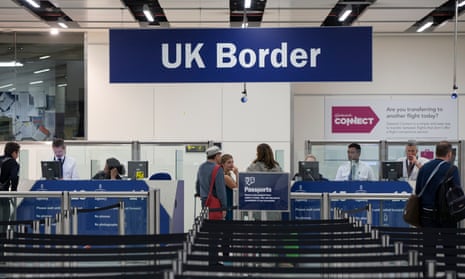The number of visas issued to allow social care workers into the UK reached record levels in 2023, according to newly released figures.
The official data also shows Rishi Sunak’s government made slow progress towards his promises to end the use of hotels for asylum seekers, slash the backlog of applications and “stop the boats”.
Home Office visa data shows that the number of visas issued to people seeking to work in the care sector, excluding dependants, reached 106,000 in 2023. Health and care visas as a whole now make up 75% of all long-term “skilled worker” visa grants, in a work visa system increasingly dominated by the public sector.
Madeleine Sumption, the director of the Migration Observatory, said: “When free movement ended, the government said that employers would have to adjust. It turns out what this meant was that other employers would have to adjust.
“Where workers are directly or indirectly employed by the government, there has been much less enthusiasm to restrict. This has meant the public sector has increasingly dominated the skilled work visa system.”
The figures released on Thursday came as the Conservatives and Labour gear up for immigration to be a key battleground at the general election later this year.
There were 128,786 in the backlog of asylum applications at the end of 2023, a drop of nearly 40,000 since September 2023 but higher than the 109,000 backlog in March 2022.
As of 31 December, there were 3,902 legacy cases – those where applications were made before the end of June 2022 – awaiting an initial decision.
In January, the Home Office was reprimanded by the statistics watchdog after the government was accused of lying about clearing part of the asylum backlog.
Sunder Katwala, the director of the British Future thinktank, said: “These figures show how the government has tackled one asylum backlog only to start building another.”
Six months after Sunak’s promise to end the use of hotels to temporarily house asylum seekers, there are 45,768 people still living in them as they wait for their applications to be processed.
On the prime minister’s key promise – to end the use of small boats by refugees to cross the Channel – the figures show some progress.
In 2023, 29,437 people arrived in the UK by small boat, down 36% since 2022. The decrease in 2023 was largely due to a 93% reduction in Albanians arriving, the report said.
The Home Office accepts that the weather caused small boat numbers to drop significantly in the latter part of last year.
There were 64% fewer small boat arrivals in the last three months of 2023 than in the same period in 2022, partly because of “poorer weather conditions”.
Afghans, many of whom were fleeing the Taliban or worked with UK forces, made up a fifth of all small boat arrivals in 2023, the largest national cohort with 5,545 people. Iranians were the second biggest national cohort among small boat arrivals, with 3,562 people.
There were 67,337 asylum applications in the UK in 2023, relating to 84,425 people, the Home Office said. This is down year on year from 81,130 applications relating to 99,939 people in 2022, which was the highest total for any calendar year since 2002.
The number of UK asylum applications refused by the Home Office jumped sharply in the last three months of 2023 – 15,380 applications relating to 19,997 people were refused in October to December. It is also the highest number of applications refused in any three-month period since July to September 2001.
